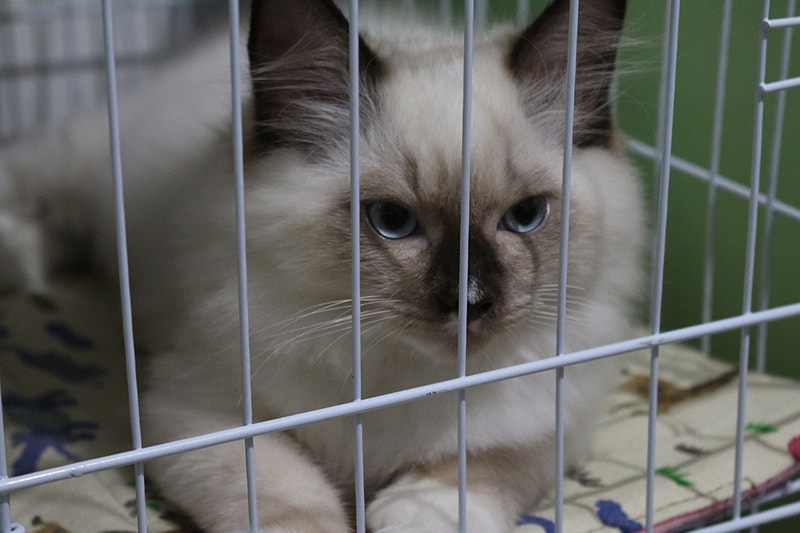How Long Can a Cat Stay in a Crate? Vet-Approved Advice
By Adam Mann
Updated on

Click to Skip Ahead
Whether you’re traveling or just don’t trust your cat while you’re not at home, there are plenty of reasons your cat might need to spend some time in a crate. But if you do need to put your cat in a crate, you don’t want to do it for too long.
If your cat seems comfortable in their crate, they can be left in there for several hours (up to 6) while you’re away, provided they have access to food, water, a litter box, toys, and a scratching post. Do not force your cat into a crate if they’re not accustomed to it.
Please note that in some cases, the terms ‘cat crate’ and ‘cat carrier’ are used interchangeably.
Carriers are small transport units, and your cat shouldn’t be housed in them for extended periods of time. They should only be used for transporting your cat (for example: to the vet).
Crates are larger and appropriate as a temporary place to house your cat if needed. They may also be referred to as cages by some people. In this article, we are discussing cat crates.
Regular Crating Limits
If you need to crate your cat regularly, most experts agree that you shouldn’t crate them for more than 6 hours each day. This means they need at least 18 hours each day outside of a cage for them to explore. This means they need at least 18 hours each day outside of a cage for them to explore.
You should begin by introducing your cat to their crate for a short duration to gauge their reaction to being crated. If your cat seems comfortable in their crate, you can gradually increase the time they spend in their crate.
- It should be large enough to let your cat comfortably lay down, stand, turn and stretch.
- It should have secure bowls for food and water. This is very important for long distance trips.
- If you intend to leave your cat in a crate for long periods of time, it should also have a litter box, scratching post, some comfortable bedding, and toys.
It’s a good idea to get your cat accustomed to a crate even if you don’t plan on leaving them in their crate on a day to day basis. At times, your vet may recommend a cage rest for your kitty. A cat used to being in their crate will have an easier time adjusting to the change in their schedule.

Occasional Crating Limits
While you shouldn’t crate your cat for more than six hours each day, this is if you plan on consistently crating them. If you need to crate them for the occasional activity, you can usually crate them a bit longer.
But even in these situations, it’s best to limit their time in a crate to 8 hours a day. However, in true emergencies, when you don’t have any other choice, you can crate your cat a bit longer, but you still need to let them out around the 12-hour mark.
The 5 Reasons You Might Need to Crate a Cat
There are more than a few reasons you might need to put your cat in a crate, and it’s why you should always have one on hand, even if you don’t plan on crating your cat. Below, we’ve highlighted five different reasons you might need to crate your cat from time to time.
1. Introducing New Pets
When you bring new pets into your home, you need to slowly introduce them to each other. If you let your cat freely roam your home, you can’t always control how quickly the pets meet each other. In such situations, the potentially aggressive animal should be temporarily crated while the other animal can freely approach them at their own terms. For example, if you’re introducing a new kitten to your adult cat, you should crate your adult cat to assist with introductions.
But keep in mind that if you keep your pet in the cage for too long, it can create extra anxiety and energy, which can make the introduction a bit harder. It’s a fine balance you need to find, but when you do, it makes the introductions go much smoother.

2. During Mating Seasons
If you haven’t fixed your female cat and they like to get out at night, you’ll want to do whatever you need to keep them from getting out where they can breed. You don’t want to have a pregnant cat, so caging them to keep them from getting out is a better solution.
We recommend spaying your cat to keep this situation from happening every few weeks. Not only that but spaying cats can help prevent future health issues from cropping up.
3. Traveling
Whether you’re leaving your cat at home or taking them with you, there’s a good chance your cat will need to spend at least a little time in a cage while you’re traveling. This is something that qualifies as an occasional crating. If your trip is long and your car cannot accommodate a large crate, you should frequently stop to allow your cat some time to come out of the crate to eat, drink, and stretch as needed.

4. Vet Instructions
At times, your vet may instruct you to keep your cat in a crate to restrict their movement. This may be required when your vet determines that your cat needs cage rest (perhaps due to a heart condition), or if your cat is recovering from an orthopedic surgery and their bone needs additional time to heal.
5. When They Are Sick
It might not seem like the nicest thing to do when you have a sick cat, but sometimes it’s the necessary thing to do. You have to temporarily crate your cat to keep a close eye on them for observation while you arrange for a veterinary visit.
If this is the case, we highly recommend reaching out to a vet so they can let you know what you need to do and if they need additional treatment.

Alternative to Crating
If your cat needs to spend an extended amount of time in a crate for one reason or another, you might be able to avoid long stays in a crate by putting them in a smaller room. Often, you can accomplish the same results by putting them in a smaller room like a bathroom.
Ensure you give them a litter box and access to water, a scratching post, a resting area, and some toys. You can put them in a room like this for a much longer period. However, please keep in mind that a large room with toys and other accessories is not a substitute for social interaction and placing your cat in such a room is not an excuse to ignore them for extended periods of time.
- Related Read: How to Crate Train a Cat: 5 Proven Tips & Tricks
Final Thoughts
There’s nothing wrong with putting your cat in a crate from time to time, but you certainly don’t want to overdo it. If they need a crate because of behavioral problems, ensure you’re working on the problem behaviors while they’re out of the crate. That way, you can slowly transition them away from it.
You’ll still need the crate occasionally, but over time, you should be able to use it less and less!
Featured Image Credit: Anna Krivitskaya, Shutterstock














